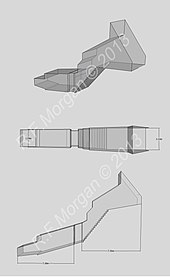WV25
|
WV25 (KV25) |
|
|---|---|
| place | Valley of the Kings (West Valley) |
| Discovery date | 1817 |
| excavation | Giovanni Battista Belzoni |
| Previous WV24 |
The following KV26 |
The ancient Egyptian tomb WV25 , also known as KV25 , is located in the Valley of the Kings and was discovered by Giovanni Battista Belzoni in 1817 . Its designation WV ( W est V alley) refers to the location of the grave, as it is not in the eastern valley like the other royal tombs, but in the western valley like WV22 , WV23 , WV24 and WVA .
Research and Publication
WV25 was discovered in 1817 by Giovanni Battista Belzoni, who also excavated the tomb in the same year and published his work in 1820 in Narrative of the Operations and Recent Discoveries in Egypt and Nubia .
James Burton and John Gardner Wilkinson visited the grave in the period from 1825 to 1828. It was not until 1972 to 1973 that further excavations were carried out by Otto Schaden for the University of Minnesota . Schaden published his results in 1979 in the Annales du Service des Antiquités (ASAE).
Location and architecture
WV25 is located in the southwestern part of the western valley in the Valley of the Kings and about 90 m below the grave WV23 , the grave of Eje . The unfinished and undecorated tomb consists of an entrance path, the first seven steps of which are made of stone blocks that had been laid on the earth in the mother rock. The following 18 steps were carved out of the rock. The entrance ends with a doorway at the foot of the stairs, the bottom step of which ends in a system shape and merges into a single corridor. This type of processing is not found before the time of Amenhotep III. even after Eje's time.
Due to the dimensions and the processing of the unfinished complex, it is assumed that it is a begun royal tomb, the execution of which corresponds to the time of the New Kingdom (1550 to 1070 BC - 18th to 20th dynasty) and the 18th Dynasty is assigned.
The Egyptologist Elizabeth Thomas noted:
"[...] from the planning point of view certainly royal destiny and [...] contemporary to the identified graves in the wadi."
The walls are carefully hewn and covered with a thin layer of stucco. At the time of its discovery by Belzoni, the entrance to the corridor was closed by a stone wall.
Finds
Various objects were found in the grave: sculptures, grave equipment, written documents, vessels and mummy bandages. Furthermore, WV25 contained a total of four mummies in coffins, which were in two rows and covered with mud. According to Belzoni, these post-burials are to be assigned to the Third Intermediate Period (1075 to 652 BC - 21st to 25th Dynasty). Until the invasion of Belzoni, the tomb had remained untouched from that time.
During the exposure in 1972/1973, Otto Schaden found some objects that he assumes came from the nearby grave WV23 and had been washed into WV25.
interpretation
WV25, which is regarded as the royal tomb, is believed to have been started by Amenhotep IV (Akhenaten), but work on the tomb was discontinued because he moved his residence from Thebes to Akhet-Aton . There is also the possibility that the grave WV23, later used by Eje, was created by Amenhotep IV.
See also
literature
- Nicholas Reeves , Richard H. Wilkinson : The Valley of the Kings. Mysterious realm of the dead of the pharaohs. Bechtermünz, Augsburg 2000, ISBN 3-8289-0739-3 , pp. 116-117
Web links
Notes and individual references
- ^ Giovanni Battista Belzoni: Narrative of the Operations and Recent Discoveries in Egypt and Nubia. Thomas Davison, London 1820, pp. 223-224.
- ↑ Otto Schaden: Preliminary Report on the Re-clearance of Tomb 25 in the Western Valley of the Kings (WV 25). University of Minnesota Egyptian Expedition January 1976. In: Annales du Service des Antiquités (ASAE) 63, Cairo 1979, pp. 161-168.
- ^ A b Nicholas Reeves, Richard H. Wilkinson: The Valley of the Kings. Mysterious realm of the dead of the pharaohs. Augsburg 2000, p. 117.
- ↑ Erik Hornung : The Valley of the Kings. Beck, Munich 2002, ISBN 3-406-47995-2 , p. 26.
- ↑ Nicholas Reeves: Akhenaten. Egypt's false prophet (= cultural history of the ancient world . Vol. 91). von Zabern, Mainz 2002, ISBN 3-8053-2828-1 , p. 147.

